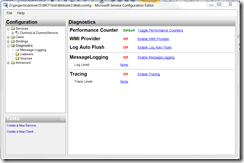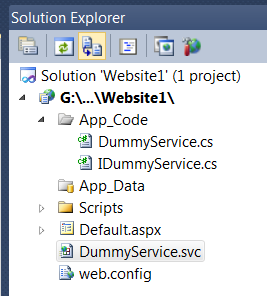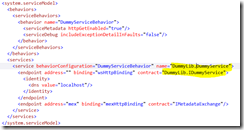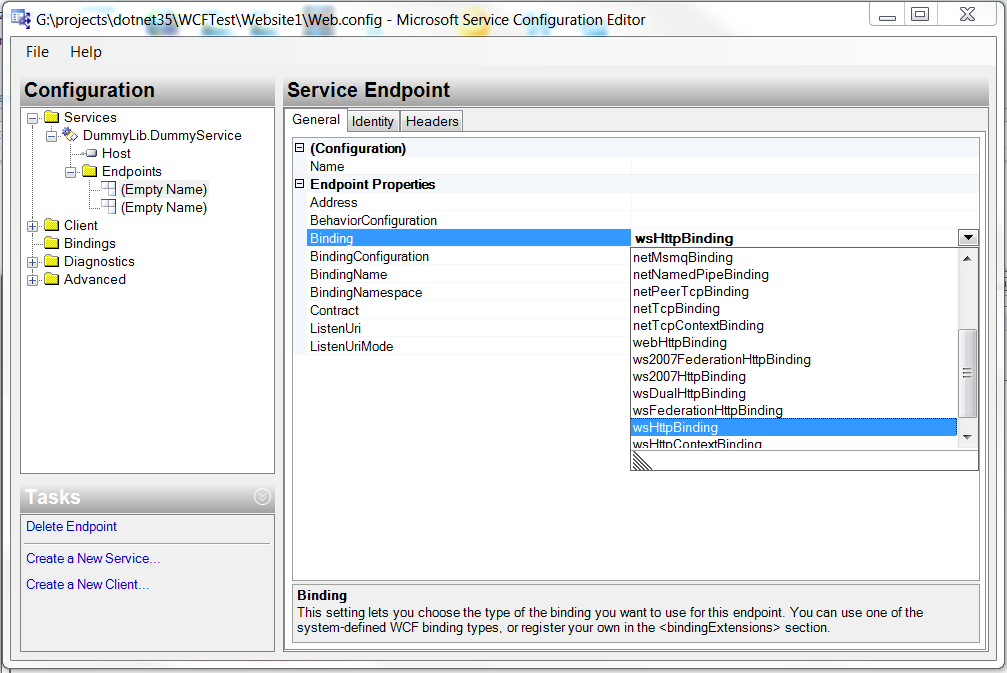Contents tagged with WCF
-
Uploading large files to WCF web services
Recently, we need to allow users to upload large files to a web service. Fortunately, WCF does support this scenario (see MSDN: Large Data and Streaming). MSDN recommends:
The most common scenario in which such large data content transfers occur are transfers of binary data objects that:
- Cannot be easily broken up into a message sequence.
- Must be delivered in a timely manner.
- Are not available in their entirety when the transfer is initiated.
For data that does not have these constraints, it is typically better to send sequences of messages within the scope of a session than one large message.
Since our files do not have these constraints, we decide to break them up into sequences of segments, and pass the segments to the web service as byte arrays. There are several remaining issues:
Firstly, by default, WCF uses Base64 encoding to encode byte arrays, resulting 4:3 ratio in encoding overhead. To avoid this overhead, WCF support both MTOM and Binary encoding. MTOM is a widely supported format that sends large binary data as MIME attachments after the soap message. Binary encoding is a WCF proprietary encoding format. It is extremely easy to use either formats. Just change the messageEncoding attribute in the binding element in the configuration from Text to Mtom or Binary.
Secondly, experiment shows that high level handshake through web service is fairly slow. Better performance can be achived by using a larger chunk size. By default, the maximum message size is 65536 and maximum array size is 8192. In order to transmit larger chunks, we need to increase the maximum message and array size. This can be done by increasing the maxBufferSize and maxReceivedMessageSize attributes of the binding element and the maxArrayLength attribute of the readerQuotas element. Note that increasing the maximum sizes also increases the risk of denial of service attack so select the size carefully.
Thirdly, although it is possible to configure the IIS to automatically compress HTTP responses, HTTP clients cannot be configured to automatically compress the HTTP requests. WCF has a sample custom compression encoder. It is fairly easy to use the compression encoder. Just reference the GZipEncoder.dll on both the server and the client side. The configuration settings can be extracted from the sample. The only thing that is not apparent from the sample is how to increase the message size. The maxReceivedMessageSize attribute can be configured on the httpTransport element:
To change the maxArrayLength in readerQuotas, I actually have to make a modification to the sample code:

The finish proof-of-concept application can be downloaded here.
-
Take pain out of Windows Communication Foundation (WCF) configuration (2)
I am continuing my previous part. I am going to discuss how to trouble shoot WCF problems by using WCF tracing and message logging. Again I am going to use Microsoft Service Configuration Editor discussed in the previous part. When you click the Diagnostics node on the left, you will see the following:
You would want to enable tracing and message logging. If you want to see the log entries immediately, you also want to enable log auto flush. What is the difference between tracing and message logging? Tracing captures the life cycle of WCF service call while the message logging capture the message. If you get a message deserialization error, you would need message logging to inspect the message. Once enabling the logging, you need to go to each listener to configure the log location and go to each source to configure the trace level. If you want to log the entire soap message, go Message Logging node and set LogEntireMessage to true. MSDN has a nice article on recommended settings for development and production environments.
Also, do not change the .svclog file extension when you specify the log file. This is a registered extension for the WCF tracing log file. If you double click a log file, another tool in the same directory of configuration editor called SvcTraceViewer will show up and display the contents of the log.
Recently, I have been seeing random deserialization errors in one of my WCF. After turning on full message logging, I was able to inspect the full soap message, and I see nothing wrong with the message. So what is the problem? By default, to prevent denial-of-service attack, WCF has some limits on message length, array length, string length. This can be configured in the binding configuration:
The default limit for the size of string parameter is 8192 bytes. There are clients sending string longer than that. So I had to increate the MaxStringContentLength attribute under the ReaderQuotas property. For the default of other quotas, please visit this page on MSDN.
WCF is big. I cannot discuss all the various configuration options. There are no substitutions for MSDN or a good book. I hope I have covered some common scenarios for help you get through the troubles quickly without spending lots of time navigating the MSDN documents.
-
Take pain out of Windows Communication Foundation (WCF) configuration (1)
WCF is a very flexible technology. The flexibility comes with complexity; there are many configurable pieces. It is usually relative easier to start with an ASP.NET project and add WCF service to it. However, as we start changing things and deploying web service to production, many unexpected problem could occur. I have written many WCF web services in my life but I don’t spend high enough percentage of my time working WCF. So I went through the same struggle again each time when I work with WCF. So I thought I would start documenting the experience to stop the pain.
If I started with an empty website called website1 and add a WCF service called DummyService, Visual Studio will added the DummyService.svc as well as the associated interface and implementation in the App_Code directory.
The contents of the .svc file looks like:
Everything works fine and makes sense, but both the service interface and implementation class lives in the global namespace. Now supposing I like to put business logic in a library project, I add another library project with namespace DummyLib and move the interface and implementation into the library project. I add the reference to System.ServiceModel in my DummyLib project and add a project reference to DummyLib into my website. Now I need to change my .svc file. Obvious, I do not need the CodeBehind attribute any more as my code is compiled by my library project. How do I reference the class? According to MSDN, the Service attribute should point to "Service, ServiceNamespace". Unfortunately, that does not work. Fortunately, like any other place where a type is referenced, I can use a type name like “TypeName, AssemblyName, etc”. Look at the web.config file and look for a type attribute and you will know what I am talking about. So now I .svc file looks like:
Is it enough? No. WCF actually stores very few information in the class and stores lots information in the web.config; that is how it could be configurable. So we need to modify the web.config to reference both the namespaced interface and namespaced class (two changes).
Now it is time to examine our web.config file. There is a serivce element that points to our implementation type. The service exposes 2 end points: one is our service end point; the “mex” endpoint if for retrieving meta data, in our case, WSDL. The web service end points to the wsHttpBinding and the mex endpoint poinsts to the mexHttpBinding. Finally, the service point to a behavior that is HttpEnabled and does not include Exception Details in fault. Confused? It is not easy to create configuration like this from scratch, but once the Visual Studio created this for us, we can feel our way to move around a bit. Fortunately, Windows SDK has a really nice tool called SvcConfigEditor. It is normally in C:\Program Files\Microsoft SDKs\Windows\v7.0A\Bin or C:\Program Files (x86)\Microsoft SDKs\Windows\v7.0A\Bin. If I open my web.config file with SvcConfigEditor, and look at the choice for end point binding:
There are lots of choices. If we work with SOAP, two common choices are basicHttpBinding and wsHttpBinding. basicHttpBinding supports an older standard of SOAP. It does not support message level security, but is very compatible with all kinds of clients. wsHttpBinding supports newer SOAP standard and many of the WS* extensions. Now supposing we have legacy clients so we need to use basicHttpBinding. We also want to use Https to secure us at the transport level. Let us see how many changes that we need to make.
Firstly, basicHttpBinding does not support https by default. We need to create a basicHttpBindingConfiguration to change the default. So I click the Bindings node on the left and then add a binding configuration calls basicHttpBindingConfiguration. Then I can click the Security tab and then the Mode from “None” to “Transport”. Now I can return to the end point and the configuration I just created is available to select in the BindingConfiguration attribute. Next, we need to go to the behavior, and add HttpsGetEnabled=”True”. Lastly, we need to go to the “mex” endpoint to change binding from mexHttpBinding to mexHttpsBinding. So to change from http to https, we need to make 3 modifications and our web.config now looks like:
In the next part, I will talk about WCF tracing and message logging. It really makes trouble shooting easier.









